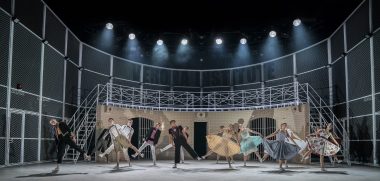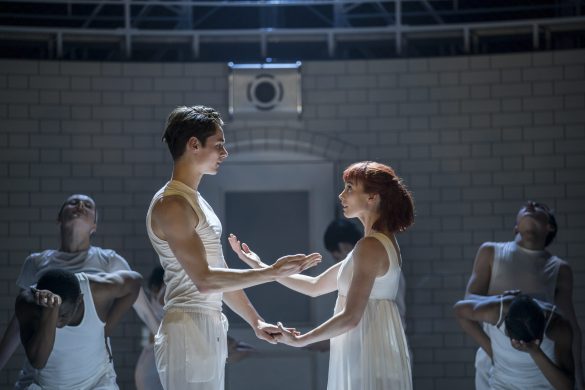 United Kingdom Matthew Bourne’s Romeo + Juliet: Dancers of New Adventures. Edinburgh Festival Theatre, 19.9.2023. (SRT)
United Kingdom Matthew Bourne’s Romeo + Juliet: Dancers of New Adventures. Edinburgh Festival Theatre, 19.9.2023. (SRT)

Production:
Music – Prokofiev (arr. Terry Davies)
Director and Choreographer – Matthew Bourne
Set and Costume design – Lez Brotherston
Lighting designer – Paule Constable
Sound designer – Paul Groothuis
Dancers included:
Romeo – Rory Macleod
Juliet – Cordelia Braithwaite
Tybalt – Danny Reubens
Mercutio – Ben Brown
Benvolio – Euan Garrett
Balthasar – Leo McCorkindale
I cannot remember the last time I arrived at the Edinburgh Festival Theatre to find the foyer so packed you could scarcely move. And so full of young people, too. Is it dance that draws them in, particularly, or is it Matthew Bourne specifically? The choreographer’s productions are famous for being fresh, revisionist takes on established classics, and Romeo + Juliet has the advantage of familiarity in being one of the most famous love stories of them all.
Bourne’s vision is a long way from Shakespeare’s Verona, however. Instead, the action is set in the sinister Verona Institute, a venue of hard surfaces and chilly whiteness. It is unclear whether this is a hospital, a prison, or some other sort of institution. Whatever, it is an austere, forbidding place, and the group scenes are characterised by mechanised, robotic movements against a sterile background. Predatory guards stalk the passageways, and one of them, Tybalt, takes sexual advantage of Juliet, one of the inmates.
Into this comes Romeo, committed to the institution by his parents, busy politicians with no time for him. His relationship with Juliet is only one of several relationships among the inmates, including a same-sex partnership between Mercutio and Balthasar that is critical to the story. This provokes the anger of Tybalt, who is murdered when the patients turn on him.
As with all of Bourne’s productions, it is fun mapping his reinterpretation onto the frame of the original. It is fresh, and it brings the advantage of making the audience think about both the story and the choreography. It is a bit of a problem staging everything in the same space, however: the claustrophobia of the institute means that there is never any sense of young love running free, and the balcony scene suffers particularly due it being snatched between flashes of the guards’ spotlight.
The story and the music are drastically cut, moreover: there is only about 90 minutes of action, yet for all that there is a lot of scene-setting in the opening and, for a short show, some passages drag. Tybalt’s murder feels prolonged, for example, and the inmates’ party scene, where Romeo and Juliet first meet, feels unnecessarily dragged out into several scenes when one would do.

Romeo + Juliet is nevertheless consistently engaging to watch, not least down to Bourne’s choreography, which charts the emotions of characters driven to the very edge. Angular thrusting and jagged angles are the order of the day, and that intensifies as the story develops. Romeo in solitary confinement strains so arduously at the edge of his emotions that he is like a caged animal rather than a wilting young lover.
The love duets are rare moments of fluidity and beauty in this context, and they are danced with beautiful flow and a beguiling sense of line by Rory Macleod and Cordelia Braithwaite. Braithwaite’s Juliet, in particular, is wraith-like and vulnerable, making her role in the unfolding tragedy all the more poignant. Macleod’s Romeo is carefully characterised with a lovely sense of detail – I loved the way he slid down the banister while his uptight parents walked down the stairs – and he is well contrasted with Ben Brown’s macho Mercutio, as well as the snarling Tybalt of Danny Reubens.
Prokofiev’s score is performed in an arrangement made especially for this production by Terry Davies. It has a strong electronic vibe, though it appears to use acoustic soloists for several key sections. It won’t please anyone who knows and loves the large-scale romantic sweep of the original, but my ear tuned into it pretty quickly, and its atmosphere suits the austere setting of the story. Bourne’s productions tend to use recordings rather than live musicians and, importantly, the quality of the recording used here is very high; much higher, truth be told, than when he tends to use full orchestral scores.
So the setting and the storytelling might not be completely gripping, and it is a little too issue-heavy in places – it tries to make points about androgyny and gay acceptance that fall a little flat, for example – but it is nonetheless a strong piece of theatre with committed performances and a fresh take on both the score and the story. And if it gets young people into the theatre to see ballet, then so much the better.
Simon Thompson
At the Edinburgh Festival Theatre until 23 September, then touring.
